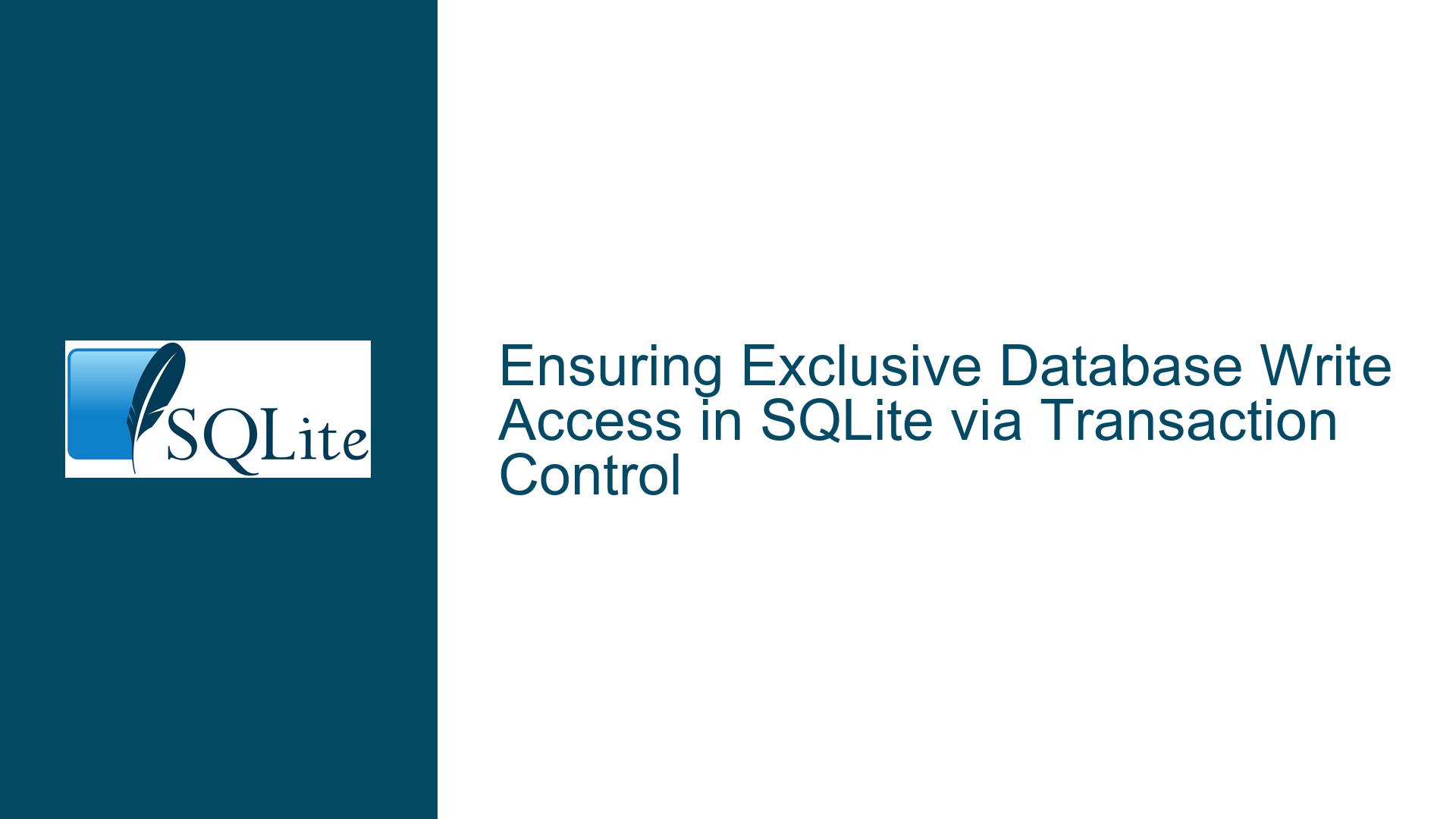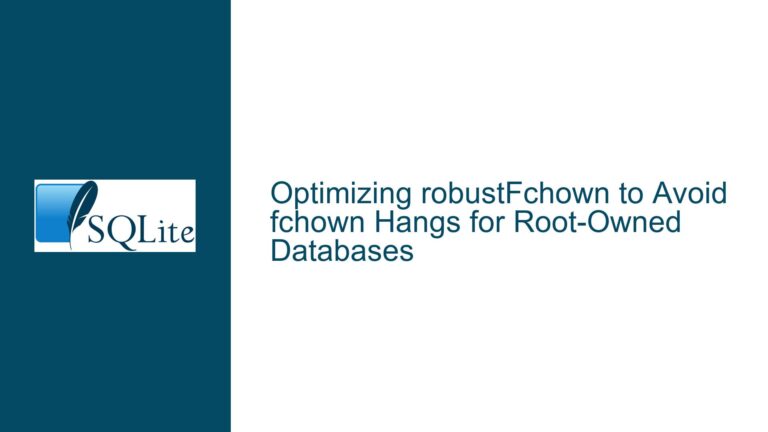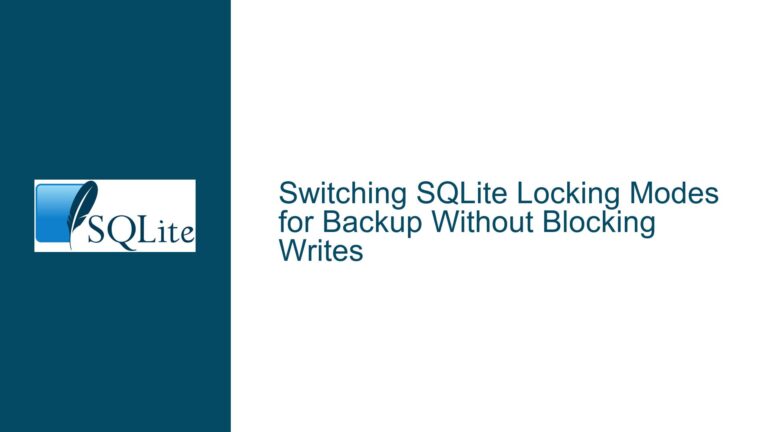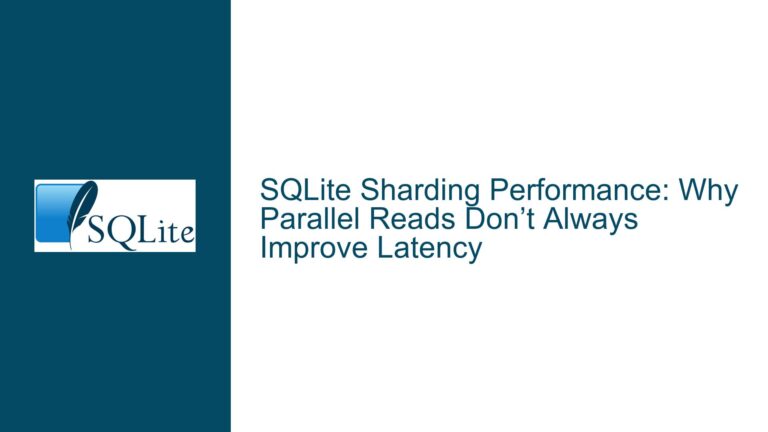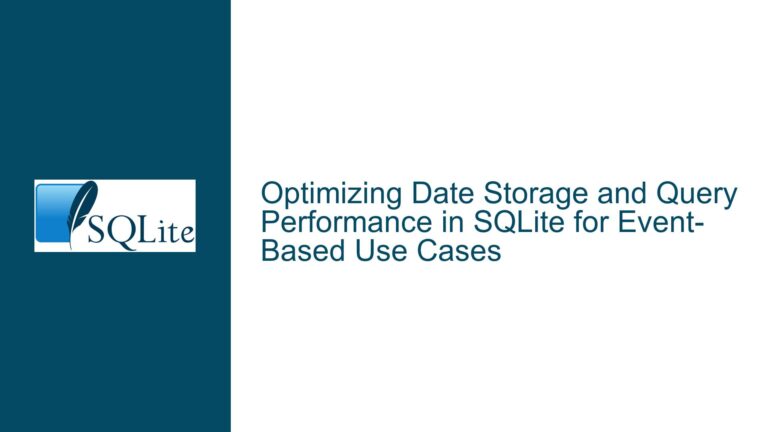Ensuring Exclusive Database Write Access in SQLite via Transaction Control
Understanding Concurrent Database Access Requirements and SQLite Locking Behavior
Issue Overview
The core challenge involves preventing multiple concurrent processes or application instances from writing conflicting data to an SQLite database. A developer creating a C library wants to ensure atomicity of write operations across separate program executions to avoid "hammering" the database with overlapping writes that could produce inconsistent or invalid records.
Key Problem Characteristics
- Concurrency Scenario: Multiple instances of a program using the same library may attempt simultaneous writes to a shared SQLite database file.
- Data Integrity Risk: Without proper synchronization, interleaved write operations could create logically inconsistent states (e.g., partial updates from different processes).
- Misconception About File Locking: Initial assumptions suggested manually locking the database file via OS-level mechanisms (
flock(),open()with exclusive flags) would solve the problem. - SQLite’s Built-In Concurrency Model: The database engine already implements locking at the transaction level, but this requires explicit configuration to achieve process-exclusive access during critical write phases.
Critical Misunderstandings
- Open Database ≠ Locked Database: Merely opening an SQLite database connection does NOT prevent other processes from reading/writing to it.
- Autocommit Behavior: By default, every SQL statement executes in an implicit transaction that commits immediately, allowing other writers to interleave operations.
- Journal Mode Impact: Locking granularity and reader/writer coexistence depend on the journaling mode (e.g., WAL vs. DELETE/ROLLBACK).
Root Causes of Concurrent Write Conflicts and Locking Confusion
1. Implicit Transaction Management
Autocommit Mode Surprises
SQLite automatically wraps individual SQL statements in transactions unless explicitly overridden. This means:
sqlite3_exec(db, "INSERT INTO table VALUES (...);", 0, 0, 0);
Executes as:
BEGIN;
INSERT INTO table VALUES (...);
COMMIT;
Allowing other processes to write between successive INSERT/UPDATE statements unless grouped into a single explicit transaction.
Multi-Statement Atomicity Failure
Without explicit transaction boundaries, a sequence of related operations (e.g., deducting funds from one account and crediting another) becomes vulnerable to partial execution if interrupted by other writers.
2. Journaling Mode and Locking Compatibility
Rollback Journal Mode (Default)
- Writer Exclusivity: A RESERVED lock is acquired on the database file during the first write operation of a transaction. This prevents other writers but allows concurrent readers.
- COMMIT/ROLLBACK Impact: The lock escalates to EXCLUSIVE during commit, briefly blocking all access.
Write-Ahead Logging (WAL) Mode
- Concurrent Readers/Writers: Writers append to the WAL file without blocking readers, which continue using the original database file.
- Checkpointing: Periodic merging of WAL changes into the main database file introduces different locking dynamics.
Misconfigured Journal Modes
Using WAL mode without understanding its concurrency implications can lead developers to mistakenly believe exclusive access isn’t enforced.
3. Missing or Incorrect Busy Handling
Busy Timeout Omission
Without configuring a busy timeout, concurrent write attempts return SQLITE_BUSY immediately instead of retrying:
sqlite3_busy_timeout(db, 5000); // Retry for 5 seconds before failing
Busy Handler Customization
Advanced use cases may require application-specific logic for contention resolution, which isn’t implemented by default.
Implementing Process-Exclusive Writes via SQLite Transactions
Step 1: Enabling Explicit Transaction Control
Starting an Exclusive Transaction
To serialize write access across processes, use BEGIN EXCLUSIVE:
int rc = sqlite3_exec(db, "BEGIN EXCLUSIVE;", 0, 0, &errmsg);
if (rc != SQLITE_OK) {
// Handle error (e.g., database is locked by another process)
}
Executing Critical Operations
Perform all necessary writes within this transaction:
rc = sqlite3_exec(db, "INSERT INTO sensors (temp) VALUES (36.5);", 0, 0, &errmsg);
if (rc != SQLITE_OK) {
sqlite3_exec(db, "ROLLBACK;", 0, 0, 0);
// Handle error
}
Committing Changes
Finalize the transaction to release locks:
rc = sqlite3_exec(db, "COMMIT;", 0, 0, &errmsg);
if (rc != SQLITE_OK) {
// Handle commit failure (rare, but possible with filesystem errors)
}
Step 2: Configuring Journal Modes Appropriately
Checking Current Journal Mode
sqlite3_exec(db, "PRAGMA journal_mode;", print_mode_callback, 0, &errmsg);
Switching to WAL Mode (If Appropriate)
sqlite3_exec(db, "PRAGMA journal_mode=WAL;", 0, 0, &errmsg);
WAL Tradeoffs:
- Concurrency: Allows one writer and multiple readers simultaneously.
- Exclusivity Requirements: Use
BEGIN EXCLUSIVEwhen absolute write serialization is needed.
Step 3: Handling Lock Contention Gracefully
Setting a Busy Timeout
sqlite3_busy_timeout(db, 30000); // Wait up to 30 seconds for locks
Implementing a Custom Busy Handler
int custom_busy_handler(void *data, int attempts) {
if (attempts >= 5) {
return 0; // Abort after 5 retries
}
usleep(100000); // Wait 100ms between attempts
return 1; // Retry
}
sqlite3_busy_handler(db, custom_busy_handler, NULL);
Step 4: Validating Process-Exclusive Access
Testing Concurrent Writes
- Process A:
BEGIN EXCLUSIVE;
INSERT INTO log (message) VALUES ('Process A started');
-- Simulate long operation
SELECT sqlite3_sleep(5000); -- Sleep for 5 seconds
COMMIT;
- Process B (Run Simultaneously):
BEGIN EXCLUSIVE; -- Will block until Process A commits
INSERT INTO log (message) VALUES ('Process B started');
COMMIT;
Expected Outcome:
- Process B’s
BEGIN EXCLUSIVEblocks until Process A’s transaction completes. - The
logtable contains entries ordered by commit time, not interleaved.
Step 5: Avoiding Common Anti-Patterns
Premature Connection Closing
Myth: Keeping a database connection open inherently locks the file.
Reality: Only active transactions hold locks. Idle connections don’t block others.
Overusing Exclusive Transactions
When Not to Use:
- Read-only operations.
- Batches of independent writes where atomicity isn’t required.
Ignoring Transaction Scope
Dangerous Practice:
sqlite3_exec(db, "BEGIN EXCLUSIVE;", 0, 0, 0);
// ... do work in other functions ...
// Forget to COMMIT/ROLLBACK
Result: Locks persist indefinitely, causing system-wide contention.
Step 6: Debugging Locking Issues
Identifying Lock Holders
Unix/Linux: Use lsof or fuser to list processes accessing the database file:
fuser -v database.sqlite
Windows: Process Explorer’s "Find Handle or DLL" feature.
SQLITE_BUSY Analysis
- Check for Missing COMMIT/ROLLBACK: Orphaned transactions are a common culprit.
- Inspect Busy Timeout Configuration: Too short a timeout may cause unnecessary failures.
Logging SQLite Operations
Enable tracing to see transaction boundaries and lock acquisitions:
sqlite3_trace_v2(db, SQLITE_TRACE_STMT | SQLITE_TRACE_PROFILE,
(int(*)(unsigned,void*,void*,void*))trace_callback, NULL);
Advanced Considerations
Connection Pooling Strategies
- Single-Threaded Use: One global connection with proper transaction control.
- Multi-Threaded Use: Separate connections per thread with
SQLITE_OPEN_FULLMUTEX.
Leveraging Savepoints
For nested transaction-like behavior within a single process:
sqlite3_exec(db, "SAVEPOINT before_update;", 0, 0, 0);
// ... operations ...
if (error) {
sqlite3_exec(db, "ROLLBACK TO before_update;", 0, 0, 0);
}
Custom VFS for Enhanced Locking
For extreme cases requiring cross-process signaling beyond SQLite’s capabilities:
- Implement a custom Virtual File System layer.
- Integrate OS-specific IPC mechanisms (e.g., named pipes, semaphores).
Final Recommendations
- Prefer Explicit Transactions: Always wrap write sequences in
BEGIN EXCLUSIVE…COMMIT. - Set Conservative Busy Timeouts: Balance between failure responsiveness and contention tolerance.
- Monitor Long-Running Transactions: Use SQLite’s
sqlite3_get_autocommit()to detect uncommitted transactions. - Educate Library Users: Document thread-safety and process-concurrency expectations.
By rigorously applying these transaction control practices, developers can ensure serialized write access to SQLite databases across multiple processes without resorting to fragile file-locking techniques. The database engine’s built-in concurrency mechanisms, when properly configured, provide robust solutions to the challenges of multi-writer synchronization.
